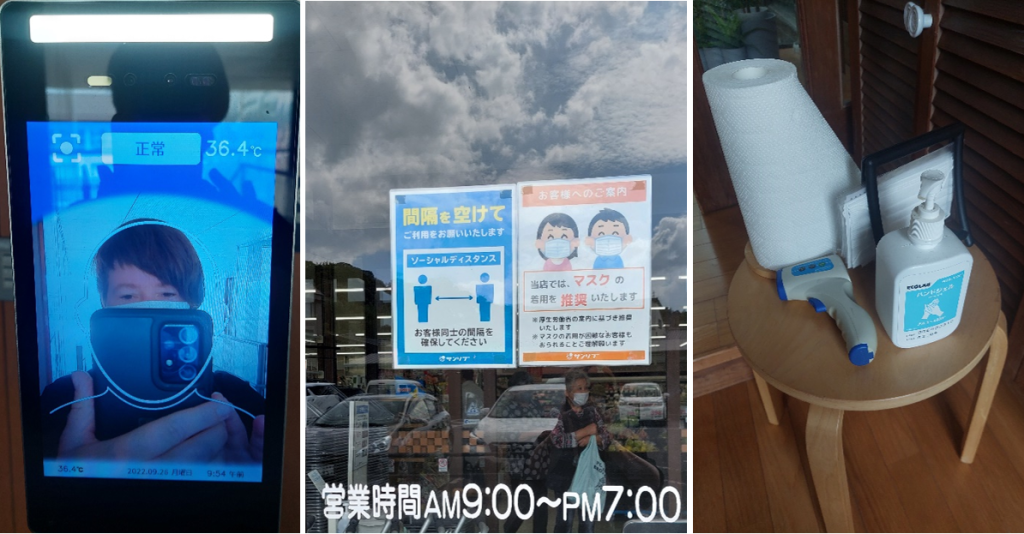by Cornelia Reiher
In September, I was able to travel to Japan for the first time after three and a half years. Since visa-free travel was not possible until October 11, I had to undergo a time-consuming visa application process. Thanks to our colleagues at Kyushu University, I was able to affiliate as a visiting scholar and was very happy when the visa was finally stamped in my passport. Fortunately, just before I left for Japan, the PCR tests for those who had been vaccinated three times were no longer required for entry. At the same time, not only the entry ban but also the war in Ukraine has made it difficult to travel to Japan. Since it is no longer possible to fly over Russia, air routes have become much longer and air ticket prices have risen sharply. Against all odds, I put on my mask, boarded a plane and entered Japan in mid-September, where I was the only foreigner in the immigration queue. I had never seen the international terminal of Haneda Airport so empty.

Alone at the immigration line at Haneda airport
Copyright © Cornelia Reiher 2022
The number of Covid-19 infections in Japan has increased since July 2022, even in rural areas. Therefore, hygiene measures were taken very seriously and everyone wore a mask indoors and outdoors. Even in my field sites, many people had already been infected with Covid. Many interlocutors told me openly that they or their children had Corona, but apparently, the subject was taboo, especially at the beginning of the pandemic. Foreigners in particular were shunned. One interviewee told me that people even changed sides of the street when they saw her, and she felt discriminated against for the first time in Japan, even though she had lived there for a long time.
Since one of the principles of good research practice is to do no harm to research participants, I followed all the formal and informal rules as much as possible. Since everyone always wore a mask, I did too. I also carried a suitcase full of Covid-19 test kits and performed tests regularly. Fortunately, I did not experience any discrimination or rejection from my research participants, but found Covid to be a good conversation starter, as everyone I met was interested in the Covid situation and rules in Germany and Europe. Many Japanese found it hard to believe that people in most European countries no longer wear masks.

Even cows wear masks during the pandemic. I found this plastic one at a michi no eki in Aso.
Copyright © Cornelia Reiher 2022
After conducting online interviews during the past year, I had come to Japan to conduct on-site interviews and attend events to see more than just people’s faces. But also during my stay in Japan, I had to interview some people remotely because they or their family members were infected with Covid-19. And this time I hardly saw anyone’s face because the interviewees had their masks on during almost all the interviews, some even in their own houses. Only when I took photos of my research participants did they briefly remove their masks. In the town halls of my two field sites, as well as in many other public institutions, a scanner at the entrance monitored the body temperature of visitors and staff. Although wearing masks is currently required in Germany only on public transportation, disinfecting hands and wearing masks even at 32°C became second nature to me (again). Like everyone else in Japan, I spent entire days without taking off my mask.

Interview with masks and partition walls in a municipal hall in Kyushu
Copyright © Takako Horita 2022
But how can a researcher relate to people if she only sees them with a mask? I found it very unfortunate that I could not see the facial expressions of many of my research participants during the interviews because they are just as important as their verbal expressions. On the other hand, I had met many of my research participants before – either online without masks or during previous fieldwork in Japan. Without these previous encounters, however, it would have been somewhat difficult for me to get to know them. Sometimes I wondered if this type of field research was really better than the online interviews I had already conducted. However, I would say that it was important to be on-site to observe the environment in which my research participants live and the social interactions in their daily lives. During the online interviews, I only saw their faces and often a virtual background. Some participants gave me a tour of their homes or neighborhood online, but I could only see what they wanted me to see. For this reason, it was important to (re)visit my field sites in person. In doing so, I not only noticed how much the places have changed since previous visits, but I also happened to come across many interesting things by coincidence. In summary, during my fieldwork in Japan, I experienced firsthand how the pandemic changed not only fieldwork for researchers outside of Japan who could not enter the country and had to find alternative ways to do fieldwork, but also fieldwork in Japan itself.

From left to right: Monitoring body temperature at the entrance of public facilities; signs that ask customers to wear masks and to keep distance at a supermarket; and the check-in equipment at a guesthouse (tissues, disinfection spray, masks and a fever thermometer).
Copyright © Cornelia Reiher 2022
